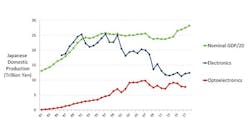For 23 years the OSA Industry Development Associates (OIDA; Washington, DC) has met with its counterpart optoelectronics trade associations from around the world to share information on new initiatives, technology trends, and market data. This year, Dr. Christoph Harder represented both OIDA and Switzerland at the group's meeting in South Korea in June. For several years, Japan, Taiwan, and South Korea have reported that their photonics manufacturing is moving to China, just as U.S. manufacturing started moving to Asia decades ago. Dr. Harder writes that this theme was repeated again this year.
Taiwanese photonics companies' revenues (including revenues earned from offshore operations) amount to about 10% of Taiwan's economy, according to industry estimates by the Photonics Industry Development Association, PIDA, OIDA's counterpart there. However, manufacturing operations, and jobs, are moving increasingly to China, even as ownership remains in Taiwan. Meanwhile, Taiwan's position in displays has declined as South Korea's position has risen, and Taiwanese companies are now supplying display components to South Korea.
The South Korean Association for Photonics Industry Development, KAPID, estimates that its photonics companies bring revenue equivalent to about 5% of South Korea's GNP. Samsung and LG, in particular, have scored wins in displays, most recently with QLED and OLED technology, and South Korea is also strong in LEDs and other products. The country's strong economic growth since the 1950s is striking, but now contrasts sharply with lower labor costs in China, not to mention North Korea. Most troubling for the South Korean companies is that the value of its exports of optics and photonics products has declined every year since 2012, in both Korean won and in U.S. dollars.
Japan's Optoelectronics Industry and Technology Development Association (OITDA) estimates that its photonics companies bring revenue equivalent to about 2.5% of Japan's GNP. The country was once strong in cameras, displays, and many other photonics technologies that have declined due to competition elsewhere, or for other reasons. And a recent revival of solar energy after the Fukushima accident has slowed. The figure shows Japan's domestic production of optoelectronics and electronics products (in trillions of yen), with the nominal GDP shown for comparison (scaled by 1/20). The Japanese economy was flat for about two decades and is now on the rise, while its domestic optoelectronics production peaked in 2007 and has cycled since. Japan's domestic electronics production has fared much worse, with its best years in the 1980s and 1990s.
Another topic at the meeting of trade associations was the trade war, not surprisingly. It is not disputed that the U.S. has low import tariffs and that China and other countries have higher tariffs. Moreover, World Trade Organization (WTO) policy recognizes the right of developing countries to protect their industries more than developed countries. What's not well understood abroad is the justification for the U.S. to have the same import tariffs as other countries, whatever the level of the tariff itself. In other words, government policy on what determines "fair" trade right now depends on where you live and which products you're referring to.
OIDA will be publishing presentations from the IOA meeting in an upcoming OIDA Market Update.
SOURCE: OIDA September Newsletter; http://www.osa.org/industry
About the Author

Gail Overton
Senior Editor (2004-2020)
Gail has more than 30 years of engineering, marketing, product management, and editorial experience in the photonics and optical communications industry. Before joining the staff at Laser Focus World in 2004, she held many product management and product marketing roles in the fiber-optics industry, most notably at Hughes (El Segundo, CA), GTE Labs (Waltham, MA), Corning (Corning, NY), Photon Kinetics (Beaverton, OR), and Newport Corporation (Irvine, CA). During her marketing career, Gail published articles in WDM Solutions and Sensors magazine and traveled internationally to conduct product and sales training. Gail received her BS degree in physics, with an emphasis in optics, from San Diego State University in San Diego, CA in May 1986.
